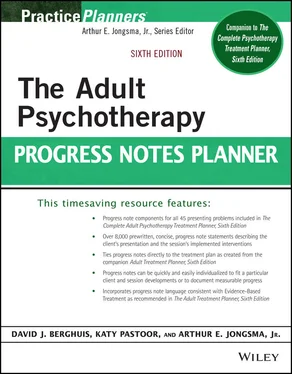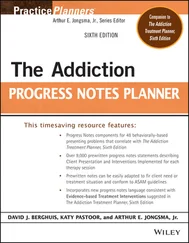22 Discuss Rationale for Treatment (22)A rationale for treatment was discussed where the focus will be on improvement in organizational and planning skills, management of distractibility, cognitive restructuring, and overcoming procrastination.The client had a clear understanding of the rationale for treatment, and this was reinforced.The client seemed to struggle with understanding the rationale for treatment and was provided with additional information in this area.
23 Assign Books on ADHD (23)The client was referred to specific reading material designed to increase his/her/their knowledge about ADHD.The client was assigned Mastery of Your Adult ADHD—Client Workbook (Safren et al.).The client was assigned The Attention-Deficit Disorder in Adults Workbook (Weis).The client has followed through on reading the recommended books, and key concepts were processed within the session.The client has not followed through on reading the assigned material on ADHD and was encouraged to do so.
24 Assign Self-Help Readings on ADHD (24)The client was assigned self-help reading to facilitate his/her/their understanding of ADHD.The client was assigned Driven to Distraction (Hallowell and Ratey).The client was assigned Hyperactive Child, Adolescent, and Adult (Wonder).The client was assigned to read Putting on the Brakes (Quinn and Stern).The client was assigned to read You Mean I'm Not Lazy, Stupid, or Crazy!? (Kelly and Ramundo).The client was assisted in processing the material that he/she/they have read.The client was not read the assigned information on ADHD and was redirected to do so.
25 Teach Organization and Planning Skills (25)The client was taught organizational and planning skills.The client was taught about tasks such as using a calendar and a daily task list.The client was reinforced for his/her/their regular use of organizational and planning tools.The client has not used the organizational planning techniques and was redirected to do so.
26 Develop Document Management System (26)The client was assisted in developing a procedure for classifying and managing mail and other papers.The client was taught about taking care of mail and other important document tasks in the least amount of steps.The client was taught to organize his/her/their mail and documents in one place.
27 Teach Problem-Solving Skills (27)The client was taught problem-solving skills that involve identifying the problem, brainstorming solutions, evaluating options, implementing action, and evaluating results.The client was reinforced as he/she/they verbalized an understanding of the problem-solving skill techniques.Role-playing was used to help the client apply problem-solving techniques to daily problems in his/her/their life.The client has not internalized the problem-solving skills and was provided with remedial assistance in this area.
28 Assign Problem-Solving Homework (28)The client was assigned the homework of applying the problem-solving techniques previously learned to specific, identified ADHD behaviors.The client was assigned “Problem-Solving: An Alternative to Impulsive Action” in the Adult Psychotherapy Homework Planner (Jongsma).The client has followed through with the problem-solving homework and the results of that effort were processed.The client reported success at implementing the problem-solving techniques and he/she/they were reinforced for this success.The client has had difficulty applying problem-solving techniques and he/she/they were redirected regarding implementation of these techniques.
29 Assess Typical Attention Span (29)The client's typical attention span was assessed by having him/her/them do a few “boring” tasks.The client was asked to complete an uninteresting task until the point that they report distraction.The client's level of attention during this task was used as an approximate measure of his/her/their typical attention span.
30 Break Down Tasks (30)The client was taught about breaking down tasks into meaningful smaller units.An emphasis was placed on being able to complete small tasks without being distracted, based on his/her/their demonstrated attention span.The client was reinforced for breaking down tasks into meaningful smaller units.The client has struggled to apply the use of the smaller tasks technique and was pro- vided with additional examples in this area.
31 Teach Use of Timers (31)The client was taught to use timers or other cues to remind him/her/them to stop a task before he/she/they get distracted.The client was taught about reducing the time that he/she/they may be distracted and off task through the use of timers.The client was taught the regular use of timers and other cues to remind him/her/them to stop a task before he/she/they get distracted.The client has failed to regularly use the timer technique, and was redirected to do so.
32 Teach Stimulus Control Techniques (32)The client was taught techniques that use external structure such as lists, files, and daily rituals to improve on-task behavior.The client was taught to remove distracting stimuli from his environment when per- forming a task requiring focus.The client was urged to self-reward for successful focus and follow through with on-task behavior.The client followed through with implementing techniques to increase on-task behavior and he/she/they were reinforced for doing so.The client did not follow through with implementing on-task behavior and was encouraged to do so.
33 Modify Maladaptive Self-Talk (33)The client was taught about using cognitive therapy techniques to help identify maladaptive self-talk.The client was assisted in challenging biases and generating alternatives to his/her/their maladaptive self-talk.The client struggled to identify maladaptive self-talk and was provided with specific examples (e.g. “I must do this perfectly,” “I can do this later,” “I can't organize all these things”).
34 Discuss Metacognitive Therapy Approach (34)The client was taught about using a metacognitive approach to examine his/her thinking.The client was assisted in developing a more adaptive plan based on new, less-threatening metacognitive appraisals.The client was provided with positive reinforcement for his/her use of a metacognitive approach to examining his/her thinking.The client was provided with corrective feedback toward improving his/her ability to examine thinking.
35 Assign New Cognitive Appraisal Homework (35)The client was assigned to implement new cognitive appraisal skills while doing tasks in which maladaptive thinking has occurred previously.The client was assisted in reviewing his/her/their use of new cognitive appraisal skills in his/her/their real-life situations.The client was provided with positive reinforcement for his/her/their use of cognitive appraisal skills.The client was provided with corrective feedback toward improving his/her/their cognitive appraisal skills.
36 Discuss Procrastination (36)The client was assisted in identifying both the positive and negative effects of procrastinating.The client was assisted in moving toward the goal of being more engaged and staying focused.The client was reinforced for identifying the positives and negatives associated with procrastination.
37 Apply Problem-Solving Skills to Procrastination (37)The client was taught about applying new problem-solving skills to planning as a first step in overcoming procrastination.The client was taught that for each plan, he/she/they must break it down into manageable, time-limited steps to reduce the influence of distractibility.
38 Apply Cognitive Restructuring Skills to Procrastination (38)The client was taught to apply new cognitive restructuring to challenge thoughts that encourage the use of procrastination.The client was encouraged to embrace thoughts that encourage action.The client was provided with examples of cognitive restructuring to change thoughts from procrastination to action (e.g. “I can do this later” becomes “I am going to do this right away”).
Читать дальше












